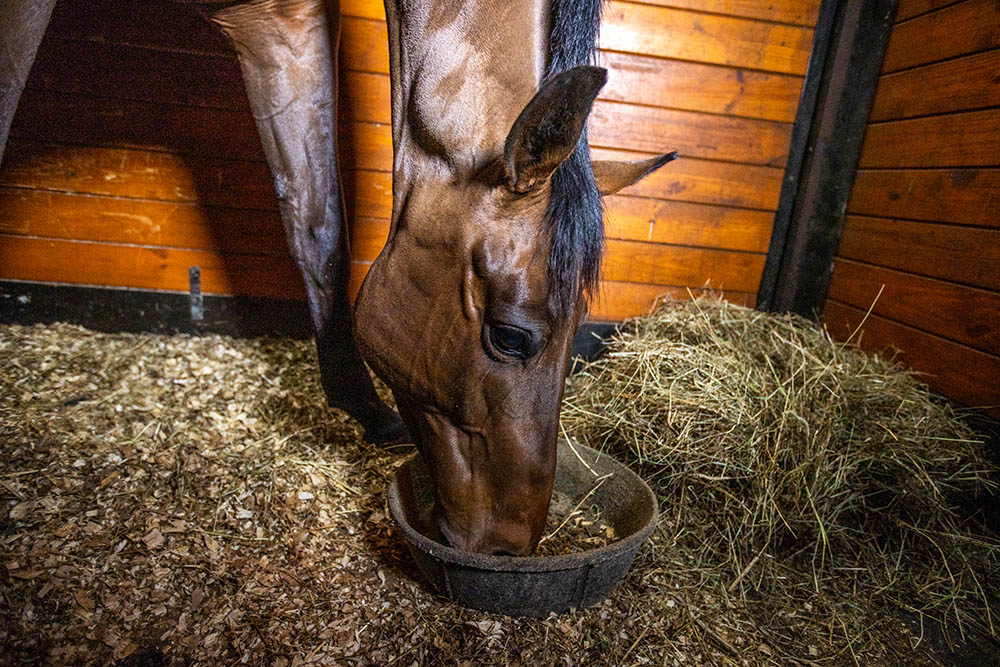In-depth discussions of the equine digestive tract invariably mention pH, especially in reference to the stomach and hindgut. What is pH and how does it factor in the well-being of horses?

In simplest terms, pH is a numeric scale used to measure acidity or basicity of any solution — grapefruit juice, drinking water, bleach, digestive secretions. The scale generally runs from 0 to 14, with 0-6 indicating acidity, 7 representing neutrality, and 8-14 signifying basicity. Useful application of the pH scale reaches far beyond household items, even into the barnyard.
THE STOMACH
As part of the digestion process, the horse’s stomach manufactures and secretes hydrochloric acid, creating a naturally acidic environment. The pH of the stomach fluctuates based on contents, both the amount and type of feed and forage. “A range of pH readings has been recorded in the stomach; the lowest of which is less than 2, the highest of which is greater than 6. Even in the best of circumstances, the stomach is an acidic environment,” said Catherine Whitehouse, M.S., a nutritionist with Kentucky Equine Research (KER).
In nature, the horse employs two main protective strategies to maintain stomach health: (1) near-continual consumption of forages, which keeps the stomach full, thus avoiding acidic sloshes; and (2) production and swallowing of saliva, which buffers, or neutralises, the acidic environment.
Many domesticated horses remain at a disadvantage as they do not have access to unlimited forage, which leaves the stomach empty for long stretches. This is expressly true of stabled horses fed one or two large meals a day. Moreover, unlike humans, horses do not produce saliva when not actively engaged in chewing and swallowing feed. When both layers of protection are disabled, the stomach lining suffers, resulting in erosion and ulceration.
Several management techniques designed to keep ulcers from forming have been identified.

“Consultation with a veterinarian
and nutritionist are best bets.”

THE HINDGUT
Further along the digestive tract, just past the small intestine, lies the hindgut, composed of the cecum and colon. Within these structures resides a population of microbes that aids in the fermentation of forages. Microbes work best when their environment, including the pH, remains fairly constant.
Though pH can rise and fall due to the quality and quantity of feed in the hindgut, explained Whitehouse, the primary reason for a precipitous drop in pH involves the overfeeding of concentrates. “When too much feed is given in a meal, the sheer bulk overwhelms the foregut (stomach and small intestine) and passes hurriedly and only partially digested to the hindgut,” she said.
“Problem is, the hindgut is not equipped to efficiently digest the primary energy sources in feed; its specialty is fibre processing. As fermentation of grain occurs, the microbial population changes when certain microorganisms die off and others thrive. These changes cause the pH of the hindgut to drop.”
Whereas a normal hindgut pH may be in the 6.5-7 range, an acidic hindgut might be as low as 5, which can bring about acidosis. Hindgut acidosis can be problematic on many levels, as horses with this condition tend to have subclinical symptoms, such as a take-it-or-leave attitude toward feed, weight loss, recurrent mild colic, unusually soft manure, or behavioural changes.
Though researchers are not completely united on the best way to measure pH of the hindgut, faecal pH is a suitable representation of what is going on in the hindgut. Commercial pH kits designed for horses are available, but consultation with a veterinarian and nutritionist are best bets.
If consultation and clinical signs point to acidosis, a hindgut buffer can be fed. EquiShure, a product developed by Kentucky Equine Research, is a time-released buffer that moderates the pH of the hindgut, making it more hospitable for beneficial microbes. EQ
YOU MIGHT ALSO LIKE TO READ THE FOLLOWING BY KENTUCKY EQUINE RESEARCH:
Equine Digestive Health: Omeprazole and the Microbiome – Equestrian Life, April 2021
New EO-3 Passes the Taste Test – Equestrian Life, February 2021

